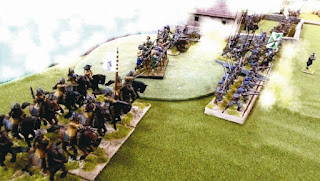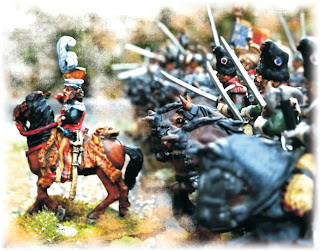Importantly, Greg got around the games with his camera and took the following of some of the action (thanks also to organiser Leigh who emailed them to us):
Ian & Greg's Disposable Heroes WWII tank action game, set in 1941.
Some of Ian's amazing collection of WWII tanks - early war Russian armour launches its assault.
Wild West skirmish action (set in colonial Australia of course!) which featured our most famous bushranger, Ned Kelly.
And finally, myself and Mark get stuck into a short BlackPowder Pike & Shotte game.
For our little TYW scenario, as we had previously only used Warhammer ECW we decided to keep it short and simple so we could familiarize ourselves with the Pike & Shotte mechanics which differ significantly in some important aspects. Despite the constant referencing to the book, it was an enjoyable and remarkably non-contentious game - the Black Powder 'gentlemen's agreement' aspect working so well we didn't even have to dice to decide anything!
The main Polish contingent led by the Pancerni race for control of the village cross road
Polish traffic-jam on the road into the village - the little wood also obstructing the Pole's deployment.
The idea was for two matched sides entering from both edges, with one flank attempting to control the village cross-roads and the main forces trying to control the main road and bridge access. The river was also fordable in two places but it never came to that as the main action took place at the other end of the table and then in the centre. The good thing with the command rules is that if you roll well enough (three or more less than the commander's rating) you can get up to three moves in per turn for each command. You tend to get stuck in pretty quickly.
Mark's Scots led by his lancers race for the same objective from the other side. Note the fearsome mortar in the foreground - fortunately for the Poles it didn't manage to hit anything. That appeared to be largely the case with all the artillery on both sides - so I don't know if we got it entirely right this game.
German Imperialists main battalia (led by the redoubtable Saxons) forming the centre didn't get off to a very good start in the 1st Turn, only managing one move initially.
The Polish Cossack-led flanking force at the other end had to negotiate a hill before finding the enemy. The Cossacks are filth but have marauder capability which means they can pretty much do as they please - both a blessing and a nuisance for their German commander as they had a tendency to just take off - anywhere!
Seeking to pin the Imperialist flank were more of the dreaded Scots lancers
In the second turn the Cossack swarm managed to get over the hill and deploy before the Scots could move up. Very cheekily they fired their bows at long range and managed (amazingly) to inflict a casualty and disorder the Scots lancers which was to have serious consequences for the Scots on the flank. Note the German cuirassier behind have deployed into line ready to charge.
After disordering the Scots lancers the cossacks by-passed them, the swarm passing through the forest and overwhelming the gun on the other side which had previously managed one of the few hits. They then swarmed on to hit one of the Scots shotte sleeves. But these Scots were made of sterner stuff and managed to hold them off.
Right behind the Cossacks, the German heavies hit the disordered Scots lancers and wiped them out. One feature of Pike & Shotte rules is when you loose, you can really loose with the defeated unit removed from the table!
In the centre a battle royal between a German and Scots pike blocks, with neither side gaining a decisive advantage. The German's shotte units were disordered by Scots musket and artillery fire and were kind of left behind when the pike decided to risk all and charge the centre of the Scots line!
They copped shooting casualties but passed their morale and were finally only disordered by the Scots pike, who also ended up disordered. After two turns of combat, both blocks retired back one move - the German's now vulnerable to the Scots extra shotte sleeves.
In the middle the Scots had been slugging it out with German Reiter across the hedge, again without either side suffering significant casualties (lousy shooting on both sides). The tide was not turned until they engaged with the Saxon shotte unit in front and were then hit at the same time by the pike block in the flank. Ouch.
In the village the Scots got to the crossroad first but were hit by the Pancerni while still in column. The Poles were closely supported by the Haiduks behind, the combat advantage enough to wipe out the other Scots lancers with the difference in the combat dice roll.
On the other side of the village the Polish shotte and light gun managed to get some shooting in at the Scot's heavy cav without result, ending in a sort of Mexican stand-off by the end of the game.
In the middle the hapless Scots were eventually wiped out by the Saxon pike (the German Reiter deciding very wisely NOT to try and jump over the hedge!) The other Scots had turned to face the oncoming victorious pike block but by this time it was the end of the game.
At the other end of the table Mark's Scots looked like they were about to be swept away by a sea of feelthy cossacks - but no! These Scots managed to not only hold them off but inflicted casualties without loss themselves. As you can't 'disorder' a swarm there was a good chance the cossacks would have run away if the game had continued and they lost another round of combat.
It was a great day's gaming and although we only managed about five full turns, the game was only two or three turns from a decisive finish - given the Scot's loss of three units and a gun it looked like victory to the German/Polish army. Mark and I were impressed with the Pike and Shotte rules and will no doubt be trying them out again soon. Also a big thank you to Leigh and Ian for organising another great day of gaming at the club - we even managed to raise some money for the Salvos - so well done to all concerned.
Cheers,
Doc





















































